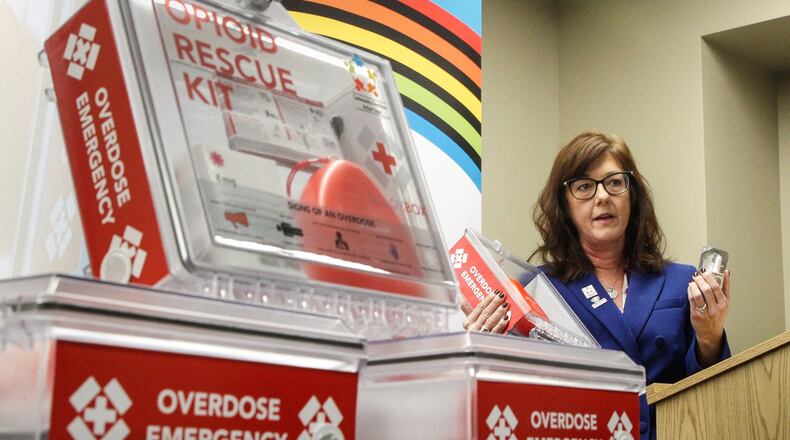MORE: Opioid overdoses followed auto plant closures, study says
“Our study shows that this change in the Ohio law allowed pharmacists to have more opportunity to participate in the management of patients addicted to opioids,” study’s lead faculty researcher Pam Heaton, a professor of pharmacy practice at UC’s Winkle College, said in a statement.
The pharmacy law change is part of broader efforts in recent years to expand access to the medication. These efforts include not just dispensing the medication but also building awareness and reducing stigma.
Neha Gangal, the study’s first author, said previous studies showed about a 14% reduction in overdose deaths in states where access to naloxone is increased. Ohio had the second highest rate of opioid overdose deaths in 2017, according to the National Institute on Drug Abuse.
The bottom line, Gangal said, is that “legal barriers needed to be removed to address this important public health crisis. Pharmacists positively impact the health of patients every day and work tirelessly to address the opioid epidemic. By providing naloxone, pharmacists save lives.”
The majority of states allow pharmacists to dispense the medicine without a prescription under varying guidelines.
MORE: Miami-Luken case raises questions of who is responsible for opioid crisis
“We want it to be talked about and available in the same way that people have band aids available,” said Helen Jones Kelley, with Montgomery County Alcohol, Drug Addiction & Mental Health Services.
Jones-Kelley said part of broadening access has meant educating people on the importance of naloxone and how it can make a life saving difference. Most recently, the ADAMHS has been supplying employers with naloxone kits.
She said one of the challenges is that some people don’t believe the public should be involved in making the overdose reversal medication available.
“That’s a very harsh view. We believe if we can save a life … that’s a victory for the community,” Jones-Kelley said.
Brenda Pahl, Cedarville University director of experiential programs and assistant professor of pharmacy practice, said pharmacists are one of the more accessible health care providers, and patients can come in without having to make an appointment. Pahl said pharmacy students learn about naloxone in school and they bring Project DAWN in to teach students.
“We have that knowledge and we’d like to be able to use it help patients,” Pahl said.
She said that patients on chronic pain medication may have their dose increased or may accidently take their medication twice, so it is highly suggested that those patients have a Narcan dose available just in case.
As of May 2019, approximately 75% of community pharmacies in Ohio were registered to dispense naloxone without a prescription.
MORE: Volunteers wanted to advocate for those in nursing homes
In the study, the research team compared 18 months of post-policy data to pre-policy data from Ohio’s Medicaid records and the database of the Kroger Ohio pharmacies, which includes prescriptions for patients with all types of insurance, not just Medicaid.
Out of Ohio Medicaid recipients, the total number of patients receiving naloxone increased from 183 patients in the pre-policy period to 3,847 patients in the post-policy period.
The analysis using the Kroger data confirmed an increase in the number of naloxone prescriptions dispensed for all types of insurance including cash prescriptions.
Researchers also found that low-employment counties had 18% more naloxone prescriptions dispensed per month compared to high employment counties.
Heaton said the uptick in low employment areas is most likely because the local pharmacy is often the sole health care contact for people living in these locations.
Lori Erion, Families of Addicts founder, said it’s a good initiative but also pointed out that Narcan is not free at a pharmacy and there are other ways to get access for free in Dayton.
Families of Adicts had held Narcan trainings through 2019 where attendees received the medication for free. Every Wednesday at noon at Samaritan CrisisCare, at the Elizabeth Place campus in Dayton, there is free Narcan training and attendees receive free medication.
She said in one example, a Rite Aid near her had a display promoting Narcan, which she thought was great, but people sometimes have bad experiences in line at a pharmacy getting medication related to addiction.
What is naloxone?
Naloxone, also known as the brand name Narcan, is an opioid antagonist that is used to counter the effects of opioid overdose, such as with morphine and heroin.
Naloxone works by blocking the effects of opioids on the brain. Opioids bind to receptors in the brain but naloxone has an even stronger attraction to the brain receptors.
“So it attaches and pushes off the opioid,” said Brenda Pahl, Cedarville University director of experiential programs and assistant professor of pharmacy practice. She said this lets the person breath normally again.
About the Author
